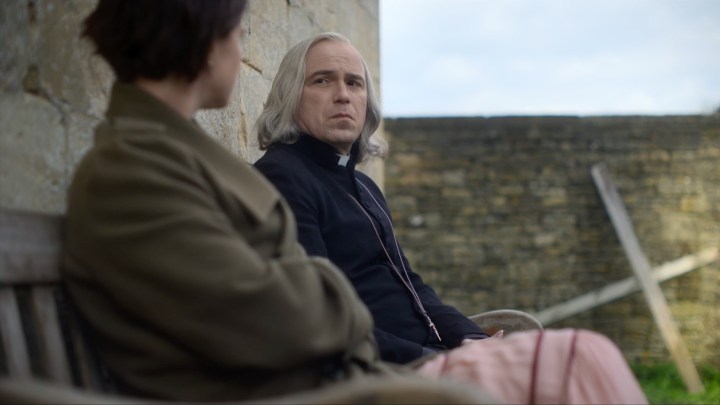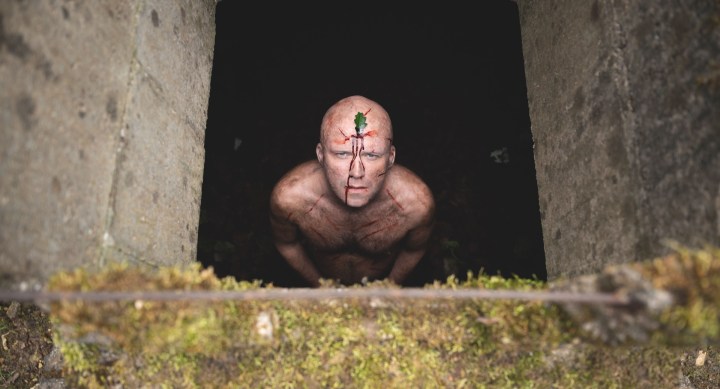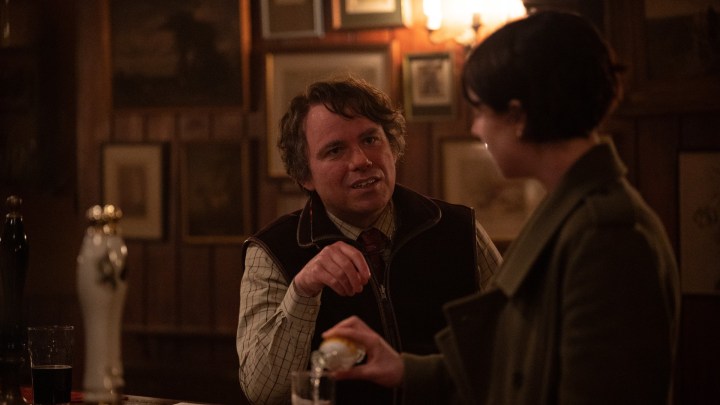If Men actor Rory Kinnear looks familiar, it’s because you’ve probably seen him playing a wide range of characters over his long career on stage and screen — sometimes in the same film or series. Director Alex Garland’s subversive horror film Men features Kinnear in nearly a dozen different roles, and it’s far from the first time the award-winning British actor has showcased his talent for portraying multiple characters in the same project, with his dual role in Taika Waititi’s Our Flag Means Death offering another recent example.
Men does, however, provide quite a few other firsts for the veteran actor. Kinnear is the focus of a terrifying, visceral final scene in Men that has already sparked plenty of discussion due to its graphic nature and — more importantly — the powerful symbolism behind it.
Kinnear sat down with Digital Trends to discuss his experience on Men, that wild final sequence, and why he keeps finding himself playing multiple characters in a single story.
The following interview contains discussion of key plot points from Men.

Digital Trends: You play so many characters in this film, sometimes even in the same scene. What was it like on your side to keep track of all of them and their mannerisms and such throughout filming?
Rory Kinnear: It was a pretty enjoyable juggling act. It did feel like I was sort of working towards capacity in terms of keeping an eye on everything, where you were in the story, where those characters were in their stories, and so on. But basically, I was playing just the one character a day, except for the the pub scene, which was the only time where I was sort of dashing in and out. When I woke up in the morning, I knew who I was going to be, and also, as soon as I got hair and makeup sorted that day, it gave me my jumping-off point into the rest of the day.
Alex Garland keeps the themes and message of his films intentionally vague, but why do you feel it was necessary to have you play all of these characters? What went through your mind about the message or themes that conveys?
Obviously, you can’t get caught up with the themes when you’re acting in it, so my takeaway from the film has been informed by seeing it. I’ve now seen it twice. By the second time, you’re beginning to see it as an audience, rather than the first time, when you’re mostly interested in how they put the puzzle together. In terms of the acting experience, while creating these characters and making sure you had justification for their behaviors, you could see what Alex was doing in terms of crafting the micro- to the macro-aggressions that these characters were displaying towards Harper (Jessie Buckley). But at the same time, for most of them, Harper was a small feature of their lives rather than hers.
But in terms of how I, as an audience member, have taken it thematically, Alex likes to keep these things opaque and I feel like I should probably fall in line with that as well. Being part of the creative process, you have an assumed degree of authority, which I don’t have here. My takeaway from the film, though, is the impact of trauma. That’s something that chimes with me. There’s this inescapable, ineluctable nature of trauma that people experience, and it repackages itself through many different and varied experiences one has — in this case, all played by the same person.
There’s this sense of repetition, this sense of deadening multiplicity, and it can echo through through your life. It’s how you try to challenge that and stop it repeating itself.

You’ve mentioned before that the big, final scene of the film was settled after you had already signed on. What was your reaction on learning what it would entail?
When it’s as big a swing as that, it’s always, “How are we going to do that?” And when it’s as bold as something like that, you’re really aware that everyone has to be so committed and inventive. The technical know-how that’s on show throughout that sequence is something that you have to take a sort of a leap of faith in when you’re performing, [hoping] that they’re not going to leave you high and dry after the event. And I’m certainly not high or dry at any point in that scene.
Definitely not.
Right? But what’s lovely about filmmaking is this collaboration, and for so much of that sequence, the collaboration was after the event. Whereas I trusted Alex, I trusted Jessie, and I trusted the crew, and knew that we could do something special ourselves with it, I also knew there were quite a lot of people I was not going to necessarily meet who were going to be in charge of making it fully realized.

Well, I do want to ask you about that, because it clearly makes a lot of use of effects — practical and digital — but there’s still so much of you in it. How do you approach that aspect of filming scenes and the need to imagine what they’ll look like in the end?
Well, the final sequence is basically a sequence between me and Jessie. There’s the birthing bit, but once each one is birthed, they have this sort of attitude or relationship with Jessie [for a brief period]. There is an even longer version of that sequence that could have been cut together, because there were lots of different alternatives that we shot throughout it.
In terms of imagining what things were going to look like, though, for the pub scene, we had people that looked a bit like those characters. The Geoffrey stand-in was in his 60s, whereas the policeman character stand-in was in his late 20s, early 30s, and they had learned the lines themselves. So we just carried on doing the scene like you would at any other time. For me, I sometimes had to keep focused so I didn’t slip into their lines, because I’d been doing it that morning, but by and large, I was able to play the scene each time as the character I was playing.

You played multiple characters on a recent show that’s been generating a lot of buzz: Our Flag Means Death. There have been a few other projects where you did that, too. Do those kinds of multicharacter performances appeal to you?
It’s funny, because I went straight off to L.A. [for Our Flag Means Death] on the back of this being filmed, and I discovered I’d gone from one makeup room with a 3D-printed image of my head staring at me for six weeks, immediately into another makeup room with a 3D bust of my head staring at me. These days you can just email the details and they print it out for you. So I’ve now played multiple versions of myself in a single scene four times. I did it in Penny Dreadful. I did it in Inside No. 9, a British show, and obviously these two as well. And it is an odd niche to have.
Maybe it’s just because I’m very cheap that they think they can get more, or maybe I’m so expensive they need to get more out of me. I don’t know. We don’t talk about these things. But yeah, in terms of changes of tone, you can’t get anything quite as distinctly different as these two.
Alex Garland’s Men, starring Jessie Buckley and Rory Kinnear, is in theaters now.



